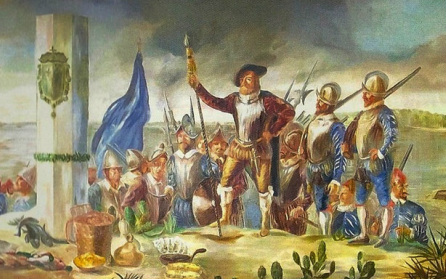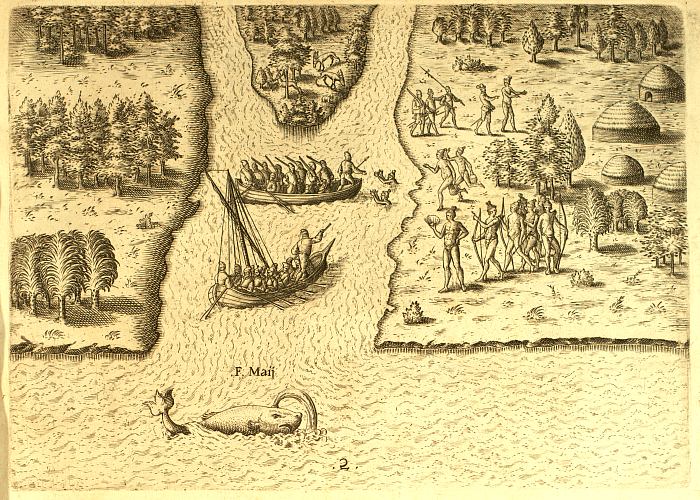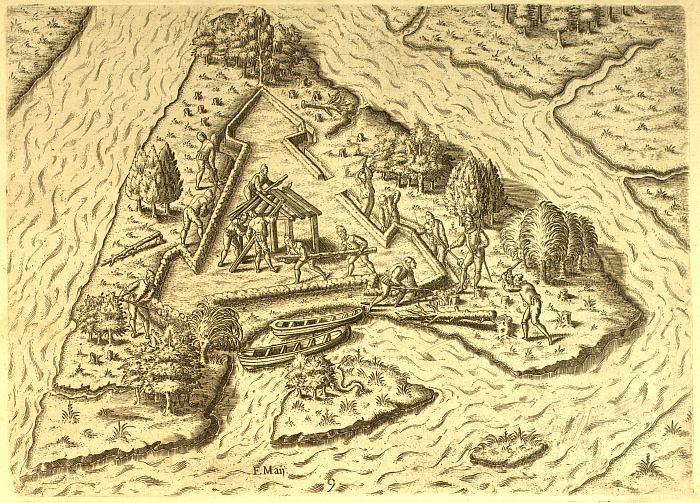May 1, 1562 - Jean Ribault lands at St. Johns, claims Florida for France
 Jean Ribault's 1562 arrival at St. Johns River. From mural by Lee Adams, 1959
Jean Ribault's 1562 arrival at St. Johns River. From mural by Lee Adams, 1959
Nearly 50 years after Ponce de Leon claimed "La Florida" for the Spanish, along came the French. This did not please the Spanish. In 1562, Jean Ribault arrived with 150 French colonists at the mouth of the St. Johns River at what is now Jacksonville, named it the "River May" and erected a stone column claiming the territory for France. The colonists were Huguenots, or Protestant Calvinists, and they were seeking to escape a war between Catholics and Protestants in France. Ribault led the Huguenots north along the coast and built a fort on Parris Island in South Carolina. They named it Charlesfort. Ribault left 27 soldiers to man the fort and traveled back to France to seek aid for the Huguenot cause. He made the mistake of going to England, thinking Queen Elizabeth I might help. Instead he was imprisoned in the Tower of London.
|
A year later, another Frenchman, Capt. René Goulaine de Laudonnière, landed in Florida with 300 new settlers and founded Fort Caroline on St. Johns Bluff. At first, they enjoyed friendly relations with the local Timucuan Indians, who gave them grain and fruit. They shared a feast on June 30, 1564 and sang a psalm of Thanksgiving. But the harmony was short lived, and tensions with the Indians increased at the same time the Spanish began looking at the fort as a challenge to their claim over the new land.
|
|
Ribault was released from London Tower in 1565 and sent to Fort Caroline with a large fleet and hundreds of Huguenot soldiers. When the King of Spain found out, he ordered the Spanish Governor of Florida, Don Pedro Menéndez de Avilés, to get rid of the French fort. The two sides waged a ship battle, and the Spanish fleet retreated south, establishing a settlement that became known as St. Augustine.
|
Ribault followed with several ships and most of his troops but was thwarted by violent weather. At the same time, Menéndez marched his forces by land and took Fort Caroline by surprise, executing nearly all of the residents who were not at sea with Ribault. Only Laudonnière and a few defenders escaped.
With all of his ships sunken or grounded by the storm, Ribault and his soldiers were stranded on shore. Timucuans spotted them and notified the Spanish, who sent an armed boat and invited the French to surrender. For some reason, Ribault believed his men would be treated humanely and surrendered to the Spanish forces. Ribault was wrong. The Spanish forces executed all but a handful of the Huguenots at what became known as Matanzas Inlet near St. Augustine. Matanzas is Spanish for massacre.
The Spanish destroyed Fort Caroline and replaced it with their own fort, San Mateo. They did not live happily ever after. In 1568, a French mercenary, Dominique de Gourgues, brought a French force to San Mateo. They destroyed the fort and killed the Spanish settlers as payback for the 1565 massacre.
Read more:
• visitjacksonville.com: Jacksonville's French Week 2014
• Viva Florida 500: Florida French Heritage Trail
• Exploring Florida: Le Moyne Engravings
With all of his ships sunken or grounded by the storm, Ribault and his soldiers were stranded on shore. Timucuans spotted them and notified the Spanish, who sent an armed boat and invited the French to surrender. For some reason, Ribault believed his men would be treated humanely and surrendered to the Spanish forces. Ribault was wrong. The Spanish forces executed all but a handful of the Huguenots at what became known as Matanzas Inlet near St. Augustine. Matanzas is Spanish for massacre.
The Spanish destroyed Fort Caroline and replaced it with their own fort, San Mateo. They did not live happily ever after. In 1568, a French mercenary, Dominique de Gourgues, brought a French force to San Mateo. They destroyed the fort and killed the Spanish settlers as payback for the 1565 massacre.
Read more:
• visitjacksonville.com: Jacksonville's French Week 2014
• Viva Florida 500: Florida French Heritage Trail
• Exploring Florida: Le Moyne Engravings


